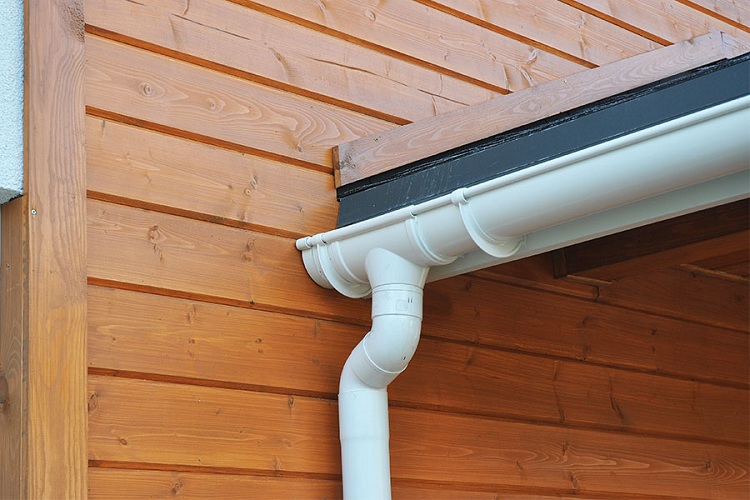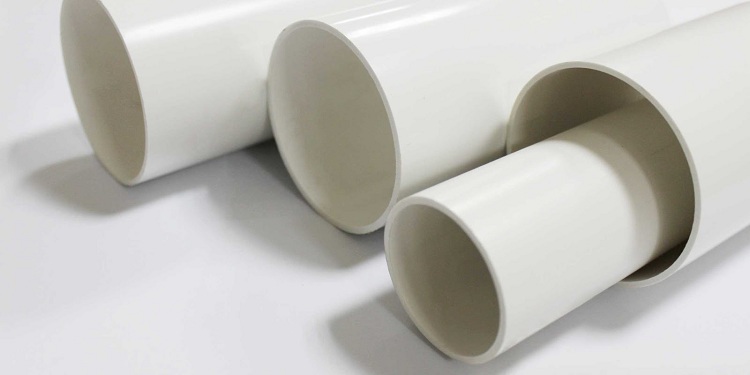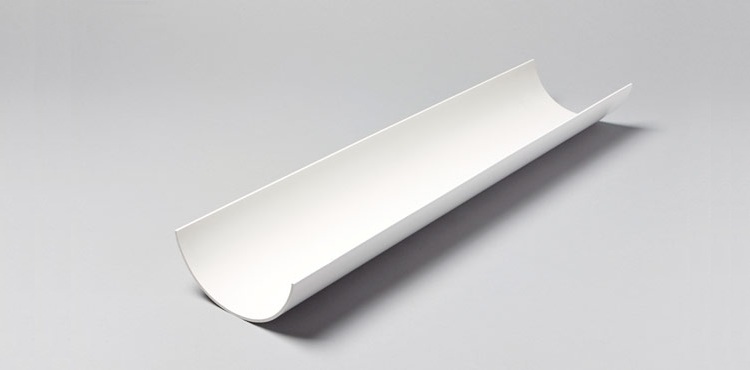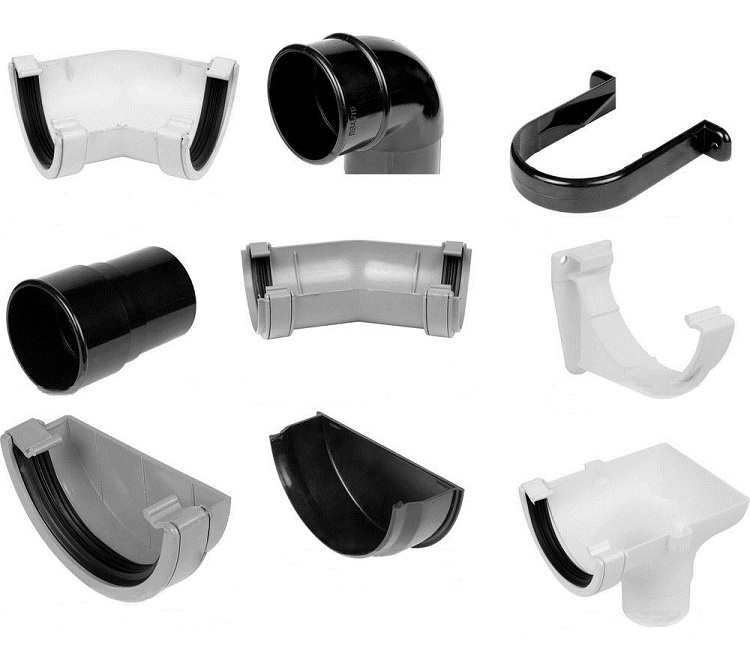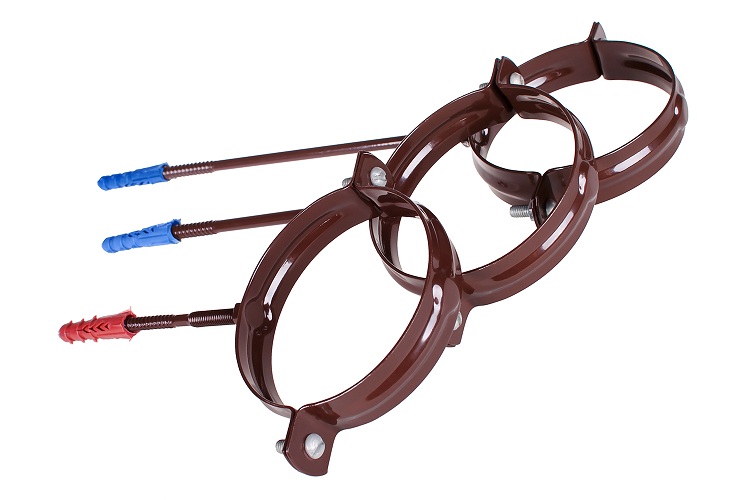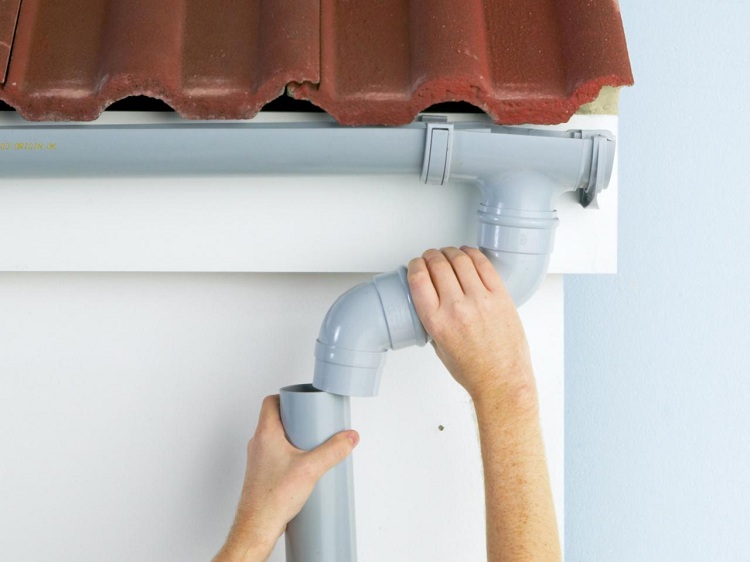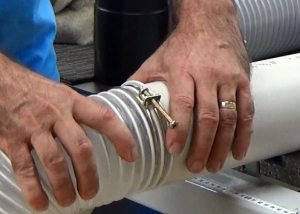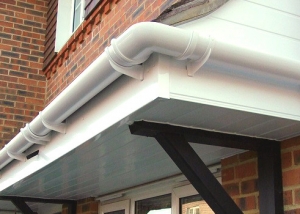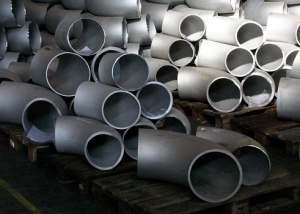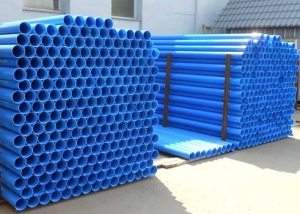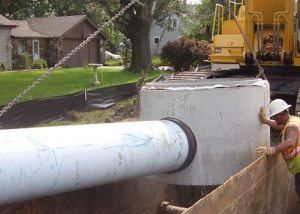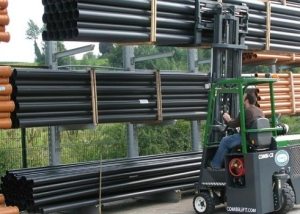The operation of suburban buildings is associated with the need to drain melt and storm water from roofing materials. For these purposes, gutters are installed around the entire perimeter of the buildings for collecting and discharging atmospheric precipitation, that is, "stormwater". You can use special parts for it, but many owners prefer to save money and collect the drain from sewer pipes, it is very simple to build such a system with your own hands.
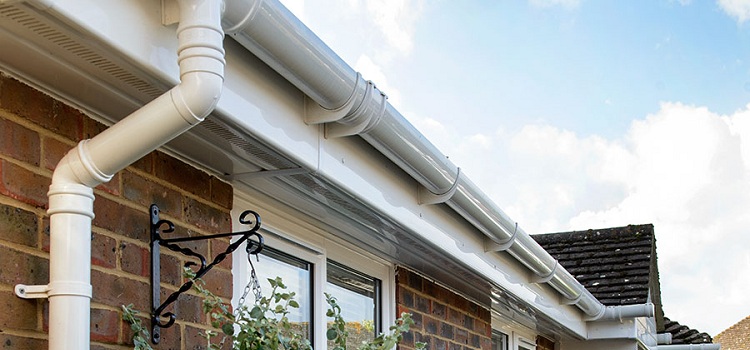
The drainage system for a private house can be assembled from any type of sewer pipes and fittings to them
Content
Purpose of gutters
In well-equipped houses, under the eaves of the roofs, open gutters are visible, where precipitation and water from the melting snow on the roof drain. This is the outer drain, which is made of galvanized steel or polymers. Finished parts with machined edges and accessories are an expensive pleasure, especially with a margin of firms for installation.
A makeshift roof gutter constructed from the remains of sewer pipes cut in half is a great alternative. Such a system meets all operational standards; a running meter is 2-4 times cheaper. Installation is quite simple, but preliminary calculations and a suitable tool are needed.
The absence of a drain is a clear example of how important such a system is in the yard of a summer house or private house. When rains are rare and short-lived, they do not bring much trouble to the owners of the building. But sharp thaws and long rains are troubles in the form of large puddles in the yard, a flooded basement and a damp foundation. The jets of water flowing down the walls of the house spoil the facade and destroy the facing materials. Even the simplest gutter, assembled from improvised materials with your own hands, will solve all these problems. Excess water can be diverted into a drainage ditch or used to distribute irrigation to a site. Drains are of two types:
- external (from sloping roofs);
- internal (with a flat roof).
Advice! Storm discharge is easier to do outdoor type. Having initial skills in working with plastic pipes, it is better to start with this option.
Characteristics of materials suitable for a drain
Polymer sewer pipes are made from different materials, but not all of them are suitable for outdoor use. In regions with cold, long winters, polyvinyl chloride (PVC) loses its universal properties at low temperatures. And t ° from -30 ° C is destructive for them, although destruction occurs gradually.
In a warm climate there is no problem in the winter with this material, but overheating in the summer heat also destroys it. They can be used as a temporary measure. Such a drain will be light and silent, unlike metal options.
Polypropylene trench also comes out cheaper than metal structures. Thick elastic pipes sometimes have stiffeners, which is very convenient for an external system.
Pipe selection
The market offers polymer pipes of different diameters and colors, they differ in properties and purpose.
1. White polymer sewer pipes
These products are widely used for the installation of sewage in buildings, indoors. They cope well with a large load, well dampen the sound of liquids circulating inside them. They are offered as the main material from which you can make a drain from sewer pipes with your own hands.
Attention! White pipes are suitable for southern regions with warm winters. In difficult conditions with a large temperature amplitude, they will last only a few years.
2. Gray pipes
In the modern market, they are most in demand, and the demand for them is growing steadily. By most characteristics, they are similar to white counterparts, but are more practical, especially for transporting hot water. If you use them for outdoor work, then they may not withstand strong extremes of low temperatures and a large load on the volume of water.
You can make roof gutters with your own hands from gray PVC pipes only if there is no severe frost in your area in winter. The large weight of water and snow is also undesirable for them, especially with weak fastening. The gutters in such a system will have to be cleaned of snow and heavy icicles.
3. Brown products
These pipes are mainly thick-walled - designed for heavy loads. They are used for outdoor sewage and underground installation. Resistant to subzero temperature and high pressure, the material is versatile. The main disadvantage is that brown pipes do not tolerate high temperature well, but in regions with frequent cooling and thaws, they are justified. The hot climate does not suit them, but such drainage does not need to be cleaned from accumulations of ice and snow.
Based on the properties of sewer pipes made of different materials, it is easy to choose the suitable option for continuous operation.
Drainage device
Gutters for installing gutters from the roof with your own hands - most often open from above elements of various shapes:
- Elliptical.
- Square.
- Trapezoidal.
- Semicircular or crescent-shaped.
The design is mounted around the entire perimeter of the roof with a slight slope. At the top point, a plug is needed to protect it from overflowing water, which should be routed through the gutters into the funnel of the stormwater inlet to the drainage groove. In addition to pipes, for the manufacture of gutters you will need:
- stubs;
- funnels;
- turning angles;
- couplings and fittings.
To form complex envelope sections of the facade, angular elements of 90 °, 120 ° and 135 ° are used. At the corners, water from the gutters flows into the pipes through the funnels; below, the water flows into the drainage ditch. Gutters and other structural elements are attached to the roof and facade with special semi-circle brackets. But they can be made of metal in the form of hooks. You will also need:
- droppers (preventing the accumulation of water under the roof);
- storm receivers (connection of gutters and pipes with storm sewers);
- baskets and nets (protection against clogging of pipes with vegetable debris).
Attention! Pipes and gutters should be installed at a distance of not less than 10 cm from the facade wall.
Essential tool for cutting and mounting:
- milling tool;
- hammers;
- scissors for cutting metal;
- marking devices;
- Bulgarian.
Advantages of drains from sewer pipes
So that meltwater and precipitation do not create problems on the site, you need to know how to properly make a drain from the roof. Homemade polymer system will have several advantages:
- ease of manufacture with your own hands;
- system economy;
- material availability;
- the ability to make accurate calculations yourself;
- always on sale components of the required diameter;
- light weight, easy transportation;
- material is not subject to corrosion;
- the possibility of using pipe residues remaining after the installation of the sewer;
- quick fragment replacement if necessary.
Drawings and schemes
The solution to the question "how to make a drain from the roof" should begin with a scheme, where all the moments of assembly and installation will be taken into account. A detailed plan provides for a drawing on which the beginning of the gutters and the slope of the system along the perimeter, the installation site of the funnels are marked.
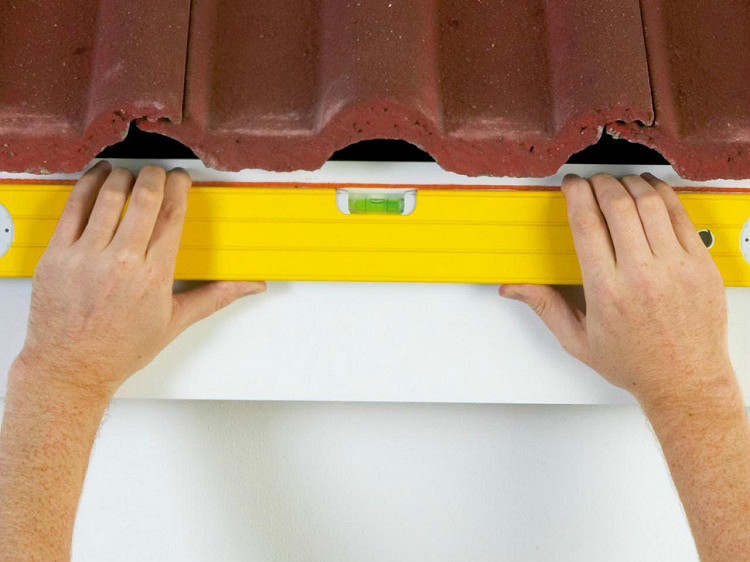
First you need to mark the places of fasteners, you need to do this, observing the slope of the future drain
It is important to calculate the number of brackets, to outline the fixation points along the roof and along the pipe leading to the groove. Two holders from opposite corners of the roof are placed under the funnels (bells of the drainpipe). Proper planning contributes to material savings and accurate representation of component procurement volumes.
Attention! The gutters are made with a slope so that the water arrives at the funnels - at least 2-3 cm per meter. Pipes of small diameter look more aesthetically pleasing, but they may not be able to cope with the volume of water that will drain from the roof during a shower.
Builders use ready-made formulas to calculate many indicators. For example, to select a pipe of the required cross-section, the roof slope and the area of the roof slope are taken into account. If it is small (up to 50 m²), a pipe with a diameter of about 80 mm is enough, 90 mm for a roof up to 120 m². For a house with a roof area of more than 125 m², pipes with a cross section of 100 mm or more will be required. Funnels and other components are selected for these parameters.
The scheme should reflect all the elements:
- The number of gutters and funnels depends on the perimeter and roof configuration.
- The number of brackets is approximately 15-17 per 10 m of the perimeter.
- Purely funnels, branches and drain pipes are the same.
- At least 2 plugs (set to the top point or the beginning of the gutter, 1 can be cut in half).
- The number of elbows is proportional to the retraction pattern.
- The number of pivoting elements and angles depends on the roof configuration (minimum 4).
- Couplings are 2 times less than the gutters themselves.
Attention! Do not confuse the number of pipes that will be cut in half under the gutters and solid billets under a vertical drain. The number of pipes cut under the gutters is half as much. For integral parts, the number of clamps and brackets is calculated separately, taking into account the number of storeys of the building.
Practice shows that the number of vertical drainpipes should be approximately 1-2 for every 20 m of the roof perimeter. They are often placed in the corners or led out to the beginning of the drainage ditch. Pipes from 50 mm are sufficient for the vertical parts of the sewer system. The ends of the drainpipe, as a rule, are formed with a bend elbow, directing the stream from the wall (foundation) in the desired direction. To mark the brackets (gutter holders) on the facade, pull the rope between the screws, make a slope and mark the fixation points.
Features of the manufacture of storm sewers
The scheme is simple and understandable, but it is worthwhile to delve into all the details of how to make how to make a drain from the roof from polymer pipes for sewage. Gutters should not be closer than 10 cm to the wall. Specialists install them in various ways:
- on the frontal strip of the cornice,
- to the edge of the rafter system,
- on the roof itself.
Advice! Fasten the pipes in horizontal section and outline the cutting line. This can be done with a grinder or universal cutting tool with a suitable nozzle.
On the sides of the gutter are joined by connecting brackets, under which the pipe pieces are shortened by 5 cm, so as not to disrupt the design calculations.The connecting part is fixed with screws and the holes are treated with silicone sealant. Finished gutters are installed on pre-prepared crescent-shaped brackets if they took round pipes to roof drains.
Fix the edges of the gutters with the antennae on the brackets or insert the spacers. This is necessary so that the edges do not deform under the influence of overheating in the sun or during overcooling in frosty winters.
After fixing the horizontal part of the water discharge, the storm outflow path is completed by the installation of vertical pipes. They are attached to the facade of the building with clamps or brackets of the appropriate shape at regular intervals - not more than 75 cm. Water is sent from the gutters by means of home-made funnels or prefabricated bells. For tightness, the structure at the joints of the sewer pipes with self-tapping screws is better to duplicate with pieces of rubber or open the perforation points with sealant.
With a large departure of the old roof from the wall of the house, it is possible to mount the gutters directly under its edges. The gutters should go under the hard roofing material by about 1/3, so that they effectively "catch" the flowing precipitation.
Important information! It is better to fix the edges of the gutters at a certain distance from the roof, so that in case of heavy snowfall it will not be demolished by an “avalanche” from the roof. Unreliable fixation by self-made brackets can destroy a self-made sewer pipe drain under the weight of heavy icicles. They form during the February "windows" with thaws and a sharp cooling at night.
How to make a drain from the roof with your own hands
An important rule for successful installation of a gutter from roofs is adherence to technology and the preparation of accurate calculations. As an example of step-by-step work, we consider all the intricacies of the construction of a home-made storm sewer from the roof.
- Fix the polymer pipes, mark and cut in half along the intended cut line. In most cases, brown sewer pipes Ø110 mm are suitable. For these purposes, use a grinder or universal tool with a nozzle for polymers. Templates will speed up the quick layout of gutters. Cut the plug for the upper end of the gutter in half, do not cut only the inlet pipes, leaving up to 20 cm.
- Finished gutters under the drain must be fixed to the wall or supporting rafters with brackets. It is better to purchase ready-made holders, but it is not difficult to do it yourself on the basis of the proposed sample. Sheet metal is suitable, but forging will be more reliable.
- Ready-made brackets are mounted on the threaded elements, starting from the upper edge with a slope to the lower vertical risers of storm drains. We start with the marking between the extreme points of the facade, driving in the cloves to tension the twine for marking. After checking the horizontal, do an offset of one end a little down - for a slope.
- Holders are mounted at equal intervals within half a meter or a little more. Similarly, clamps of vertical pipes are attached under the drain, the latter fixes the lower knee, which diverts a stream of storm sewers. The entire structure should be 10-15 cm from the facade.
- We lay the gutters from the sewer pipes on the crescent-shaped brackets and carry out the fastening (glue, aluminum clip). Sealant will protect against leakage after perforation. At the edges we fix the caps in the same way.
- Funnels or bells of the vertical east are installed without glue, and we make sealing with rubber gaskets from polymer tees.
Attention! The order of assembly of fragments of the structure is important, so that the entire flow leads to a funnel. That is, we connect the gutters with brackets and fix them with brackets, close them with plugs from the opposite (upper) end, and bring the bottom out to the funnel.
- A vertical drain is mounted on top and aligned vertically, then secured with clamps.Especially carefully we connect knees on rotary sites. We put a metal mesh into the funnels so that the fallen leaves and other plant debris do not clog into the pipes.
A self-constructed drain from sewer pipes is an economical way of arranging the removal of atmospheric precipitation from the roof. With the right approach to business, he will serve for many years without the need to replace individual fragments or the entire gutter along the perimeter of the roof. The reliable design will cope with the functional load, saving the house from uncontrolled melt and storm water.
